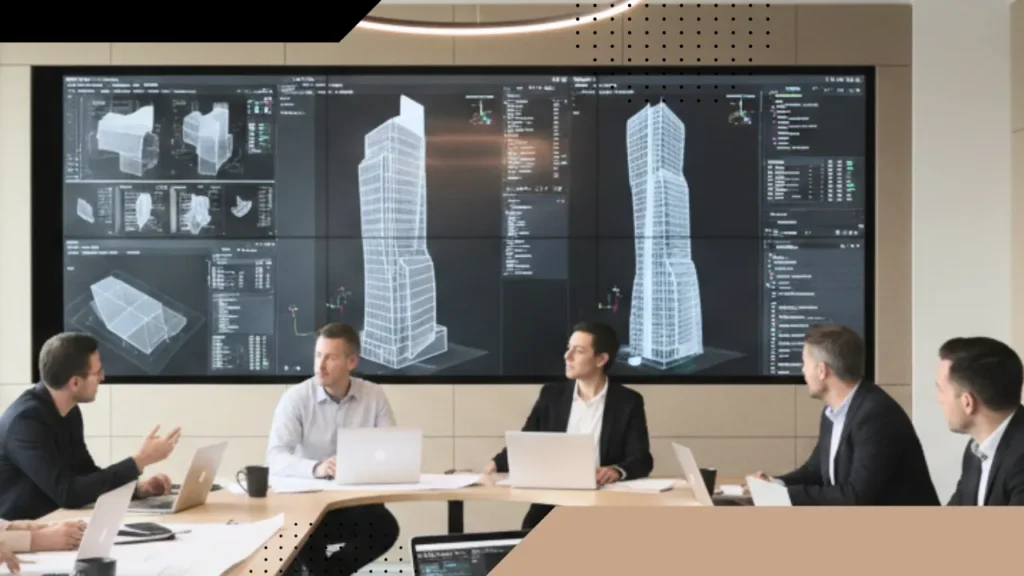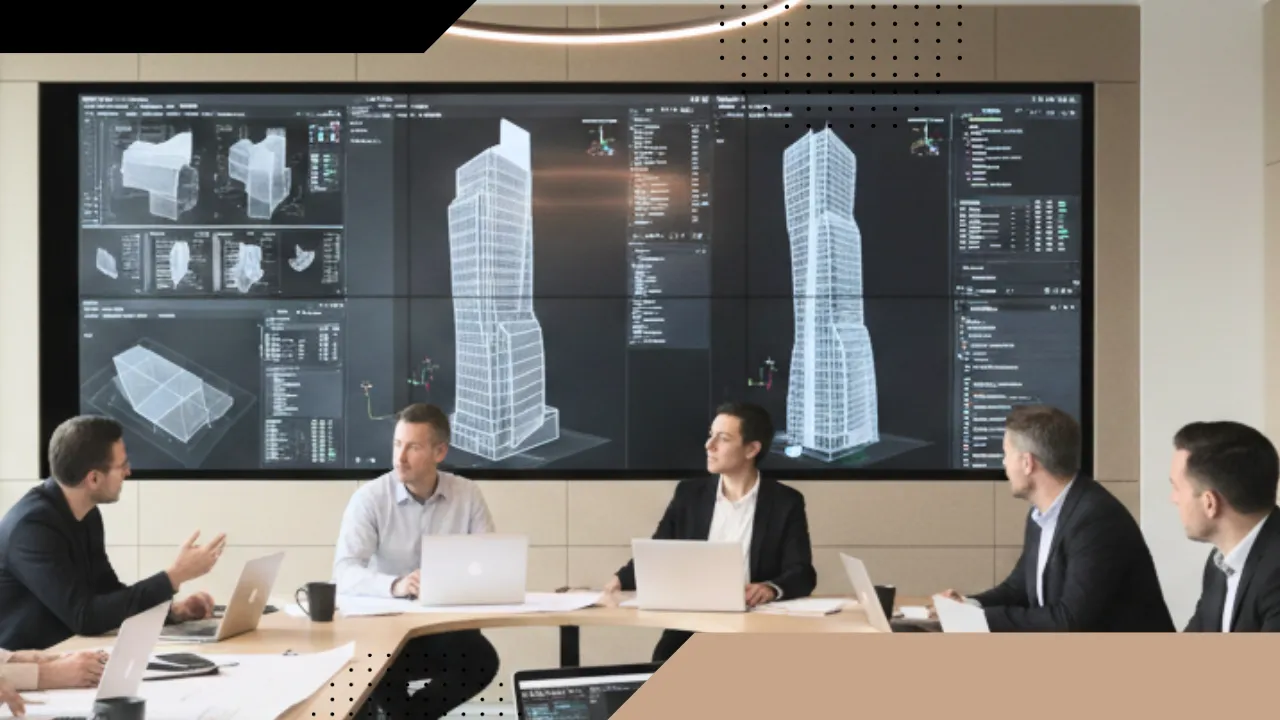In every successful architectural project, precision and collaboration are the invisible frameworks that hold everything together. Design coordination meetings are the heartbeat of this process — moments when architects, engineers, and contractors align on one shared objective: delivering a seamless project without costly rework, delays, or miscommunication.
Table of Contents
ToggleIn today’s digitized and multidisciplinary construction environment, a well-structured design coordination process is no longer optional. It’s the most effective way to translate creative vision into executable reality. Whether you are managing a residential build, commercial complex, or public infrastructure, the efficiency of your coordination defines the quality of your outcomes.
The Essence of Design Coordination in Architecture
Design coordination is the systematic process of integrating architectural, structural, and MEP (Mechanical, Electrical, Plumbing) designs into a unified and conflict-free model. During coordination meetings, each discipline reviews clashes, constructability issues, and documentation consistency before construction begins.
For architects, these meetings are a safeguard — ensuring that aesthetic intent is maintained while technical feasibility is achieved. They bridge the gap between design creativity and realistic delivery. Coordination helps teams visualize how design decisions impact materials, spatial layouts, and construction methods in real time.
Why Coordination Meetings Prevent Costly Rework
According to Industry reports, up to 30% of total project costs can be wasted due to design errors or miscommunication between disciplines. Design coordination meetings dramatically reduce this risk by proactively identifying spatial or technical conflicts early in the process.
For example, a simple duct misalignment caught during a coordination review might prevent major structural changes later. This proactive approach doesn’t just save money—it preserves design integrity and keeps projects on schedule.
Teams leveraging BIM services are particularly successful in coordination meetings. BIM technology allows multidisciplinary models to coexist and sync in shared digital environments, providing architects real-time visibility into how mechanical or structural systems interact with their designs.

Streamlining Communication Across Teams
Design coordination is as much about communication as it is about technology. Each meeting provides a structured environment where stakeholders share updates, resolve uncertainties, and prioritize issues. Without regular coordination, even the smallest misunderstanding can ripple through the project, causing schedule delays and client dissatisfaction.
When architects lead coordination discussions, they ensure that design intent remains aligned with project goals. It’s the platform where creative vision meets technical expertise—where decisions are informed, not assumed.
Integrating Design Coordination with Modern Tools
Modern coordination is data-driven. From Cloud-based file sharing to 3D floor plan design, technology allows all stakeholders to visualize updates instantly. Platforms like Revit or Navisworks facilitate clash detection and ensure design consistency across various systems.
These integrations empower architects to maintain creative autonomy while reducing technical bottlenecks. When your design coordination workflow is backed by robust technology, teams can focus more on problem-solving and less on reconciling outdated drawings.
Cloud-based coordination also enhances remote collaboration — ideal for distributed teams or firms managing projects across multiple regions. Architects can now share BIM files, 3D models, and markups in real time, reducing dependency on physical meetings.
How Often Should Coordination Meetings Happen?
There’s no universal rule, but consistency is key. For large projects, weekly or bi-weekly coordination meetings maintain momentum. Smaller-scale designs may only require milestone-based coordination sessions. What matters most is structure—each meeting should have a clear agenda, a record of decisions, and follow-up tasks to maintain accountability.
To increase efficiency, DSS clients often integrate design coordination meetings with architectural design drawing updates, BIM model reviews, and early-stage constructability assessments. This ensures issues are resolved before they ever reach site level.
Boosting Efficiency Through Collaborative Transparency
Transparency is the cornerstone of coordination. Open discussions on constraints, cost, and material limitations help maintain alignment. Architects who manage clear communication channels with consultants and builders not only resolve clashes faster but also foster a more trust-driven workflow.
Transparency boosts efficiency, but it also builds loyalty among project stakeholders—developers, consultants, and clients appreciate an architect’s diligence in ensuring the smooth flow of information.
In a traditional workflow, updates often get lost across multiple software platforms. By integrating models and hosting recurring design coordination sessions, architects can centralize all changes through a single source of truth—an essential move in reducing redundant work.
Let’s Make Your Next Project Seamlessly Coordinated
DesignSync Studio’s expert team helps architects achieve flawless design coordination through BIM integration, precise documentation, and collaborative planning.
Call us today at +1-215-995-4450
or visit designsyncstudio.com/contact-us to start your project on the right foundation.
Common Challenges During Design Coordination
Despite its importance, design coordination isn’t always straightforward. Architects often face challenges such as:
- Misaligned Revisions: Multiple design updates from engineers and contractors may overlap or conflict without real-time version control.
- Communication Barriers: When specialists use different platforms, coordination suffers without proper integration.
- Limited Model Accuracy: Lack of BIM detail or incomplete 3D data can lead to inaccurate clash detection.
Addressing these barriers begins with proactive planning — defining file standards, version management, and collaborative workflows from day one.
The Role of BIM in Enhancing Design Coordination
Building Information Modeling (BIM) has transformed coordination from reactive to predictive. Instead of waiting for field conflicts to appear, architects can now run clash detection directly within digital models, catching issues before construction begins.
At DesignSync Studio, our BIM coordination services enable architects to visualize every system in precise spatial context — from electrical conduits to HVAC layouts — ensuring accurate alignment at each stage.
BIM also enhances client communication. By sharing 3D visualizations, architects help stakeholders understand the scope and sequence of work, simplifying decision-making processes.
How Design Coordination Benefits Clients and Stakeholders
For clients, design coordination translates into consistency, accountability, and predictability. Projects stay within budget, timelines shrink, and the final deliverable is higher in both quality and sustainability.
For general contractors, coordinated design documentation minimizes on-site conflicts. For consultants, it ensures their systems integrate perfectly into the architectural layout. And for architects, it preserves both creative integrity and professional reputation.
Ultimately, design coordination meetings transform what could be a chaotic multi-discipline process into a synchronized and data-backed execution plan.
Bringing It All Together
The architectural world is moving toward integrated design, where every discipline operates on shared data and unified intent. Coordination meetings are the cornerstone of this transformation—they ensure that design creativity is grounded in constructible logic and technical accuracy.
By investing time in structured and consistent coordination, architects not only deliver better outcomes—they elevate their value in the project chain.
At DesignSync Studio, we support design teams with fully integrated coordination workflows blending architecture, BIM, and construction documentation services. From interior design details to technical BIM modeling, every layer of design is precisely harmonized for project excellence.
Conclusion
Design coordination meetings are not merely logistical sessions—they are moments of synthesis where creative ideas evolve into buildable strategies. As the architecture industry continues to advance technologically, the firms that master coordination will set new standards for project productivity, consistency, and client satisfaction.
FAQs on Design Coordination
1. What is the main goal of design coordination meetings?
The main goal is to identify and resolve design or construction conflicts among different disciplines before construction starts, ensuring project efficiency and cost control.
2. How do BIM services support better coordination?
BIM services provide an integrated 3D environment where architects and engineers can detect clashes and visualize updates instantly, improving accuracy and collaboration.
3. When should coordination meetings occur during the project?
Ideally, early in the design phase and consistently throughout project milestones. Regular sessions prevent miscommunication and keep all teams aligned.
4. Can coordination improve client satisfaction?
Yes. Clients benefit from smoother project delivery, reduced costs, and fewer on-site surprises, resulting in greater confidence and trust in the architectural team.
5. How can DesignSync Studio help with coordination?
DesignSync Studio provides architecture, BIM, and drawing documentation services that integrate coordination tools and workflows tailored to enhance your design accuracy and collaboration efficiency.


